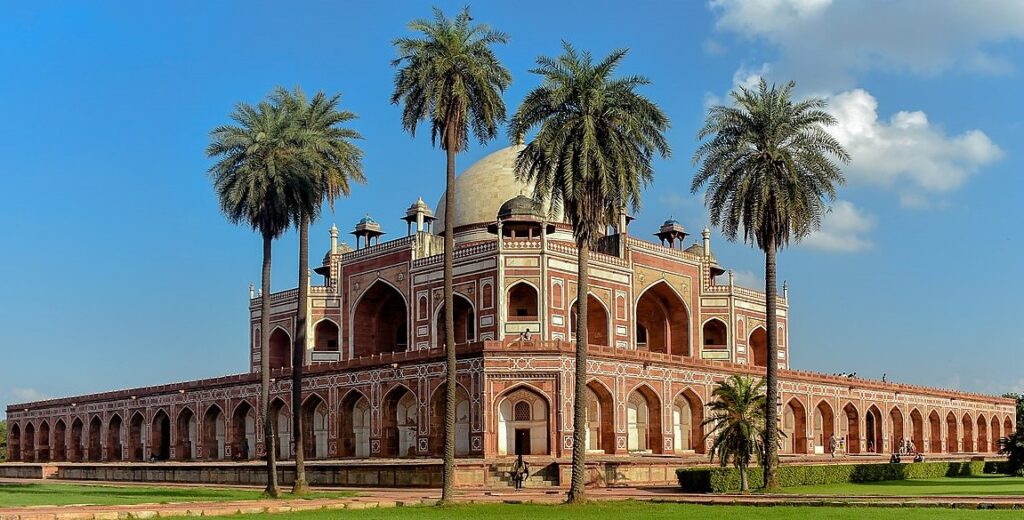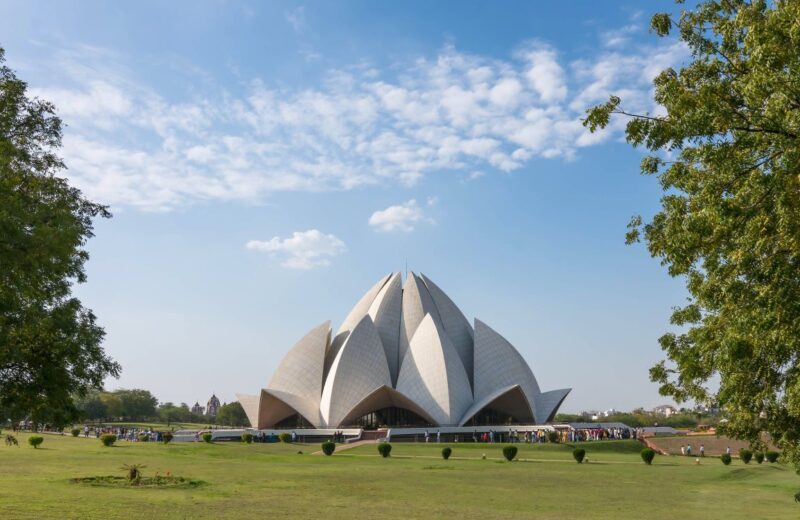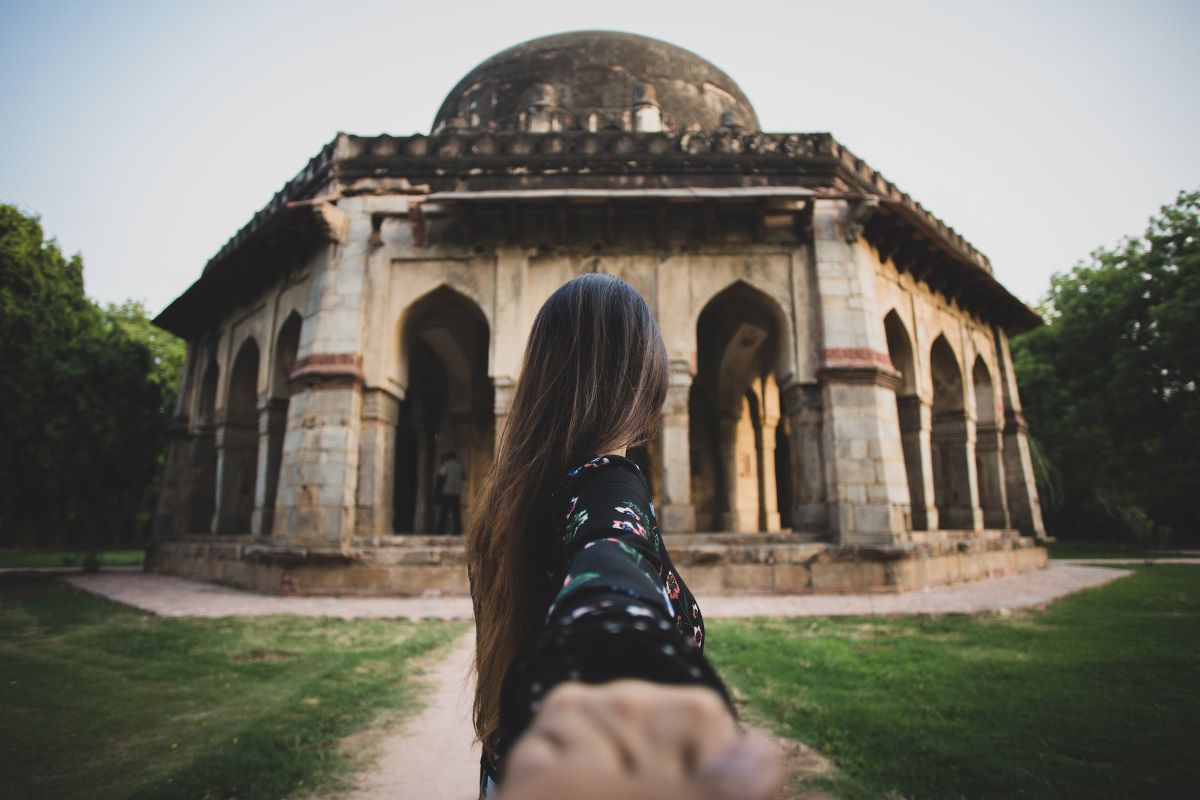Humayun’s Tomb Delhi Timings: 10:00 am – 06:00 pm
Entry Fee:
- Indian Nationals and citizens of the SAARC nations: – INR 35
- Foreigners: – INR 550
- No entry fee for children under 15 (both Indian and foreign)
- Video Shooting: – INR 25, Photography: – Free
Location: Mathura Road Opposite, Hazrat Nizamuddin Aulia Dargah, Nizamuddin, New Delhi, Delhi 110013, India ←Click here
Humayun’s Tomb, Delhi Overview
Humayun’s Tomb in Delhi is the first-of-its-sort rich sepulcher built in India and furthermore the first garden-tomb in the India. It is also known by Maqbara-e-Humayun, this magnificent 16th-centuary monument looks less like a tomb and progressively like a luxurious places. Situated in the Nizamuddin East area of Delhi, it is the first garden-tomb in the Indian subcontinent. This splendid piece of architecture was commissioned for construction by Humayun’s chief consort Empress Bega Begum in the year 1569-70 and is one of the very few structures that used red sandstone on such a massive scale at that time. The design of Humayun’s Tomb is a run of the mill Mughal architecture with Persian impacts and was conceptualized by Persian designer Mirak Mirza Ghiyas. Inferable from its great structure and celebrated history, Humayun’s Tomb was highlighted in UNESCO’s World Heritage Site in the year 1993. The building virtuoso of Humayun’s Tomb is difficult to miss.
This sublime tomb sits in a tremendous, fancy Mughal Garden and its excellence is just improved throughout the winter months. Situated on the banks of the River Yamuna, this mausoleum is also home to the remains of his wives, son and descendants of the later Emperor Shah Jahan, and many other Mughals, including many later Mughals. Need to find out about this last asylum of Emperor Humayun’s Here’s all that you should think about Humayun’s Tomb in Delhi, including its architecture, history, entry fee, timings, full details.
ALSO READ:- 10 Best Places To Visit in Agra | Agra Sightseeing (2022)
➤ Read More on Humayun’s Tomb:
➯History
This fine mausoleum was built near River Yamuna by Emperor Humayun’s first wife Bega Begum aka Haji Begum to immortalize the memory of her husband. Despite the fact that the Emperor died in 1556, it wasn’t until 1565 that the development for the monument started. After seven years of development, the tomb and the encompassing Charbagh Gardens construction finished in 1572. Given the grandeur of the memorial, it’s no surprise that the construction cost came to 1.5 million rupees, which was completely borne by Bega Begum.

Throughout the hundreds of years, Humayun’s Tomb saw a lot of disregard and decrease. In the 18th-century, the delightful garden encompassing the monument offered approach to vegetable garden. After the frontier rulers took over Delhi, the Charbagh Gardens was overlaid with an English-style garden in 1860. In any case, in the early piece of the twentieth century, the tomb complex was re-established with the first gardens at the request for Lord Curzon, the then Viceroy of India. The monument additionally assumed a significant job in the cutting edge history of India. At the time of the nation’s segment in 1947, Humayun’s Tomb alongside the Purana Quila filled in as displaced person camps for those relocating to Pakistan. For just about five years the camps were held at this site, making a lot of harm the fundamental structure and the gardens. Afterward, when the monument went under the control of the Archaeological Survey of India, it was restored to its original glory again.
➯Architecture
The structure of Humayun’s Tomb Delhi is a blend of Islamic and Persian design with smatterings of Indian tastefulness as well. Six-sided stars that adorn the main opening on the west, are additionally observed on the fundamental burial chamber tomb structure, however it has been utilized as a designed galactic symbol. The mosque likewise has the tomb of Emperor’s dearest stylist. The tomb built of flotsam and jetsam of rock and red sandstone utilizes white marble as a covering material. It has main highlights place of Indian – Islamic architecture like jaali, entryway outlines and chhajja. It remains on a jumped porch eight-meter high and spread more than 12,000-meter square. This tomb houses more than 100 tombstones and the whole base structure is raised on a phase, a couple of steps high.
➯Things to See in the Humayun’s Tomb Complex
Apart from Humayun’s Tomb, there are many other tombs and monuments are part of this complex, including:
1. Tomb and mosque of Isa Khan: This is the mausoleum complex of Isa Khan Niazi, who was an Afghan noble in Sher Shah Suri’s court. He was actually an adversary of the Mughals and had fought against them. The octagonal tomb was constructed during the reign of Sher Shah’s son Islam Shah Suri. It is surrounded by an octagonal garden and later went on to serve as the tomb for Isa Khan‘s family as well.
2. Bu Halima’s tomb and garden: This fascination is situated towards the western passage of Humayun’s Tomb. Information about Bu Halima is sparse, and the tomb is accepted to be a later expansion to this spot.
3. Afsarwala tomb and mosque: Afsarwala was a respectable in Akbar’s court, and his tomb is situated towards the southwest finish of Humayun’s Tomb. Contiguous the tomb is a mosque which is also believed to be committed to Afsarwala. These constructions belong to the period of 1566-67 CE.
4. Arab Sarai: This was a safe house meant for craftsmen doing construction work.
5. Nila Gumbad: Right outside the boundary of the complex is the Nila Gumbad or “Blue Dome”, which is embellished with blue tiles. It has a unique structure which is octagonal from the outside and is a square from within. It was built by Abdul Rahim Khan-I-Khana who was a courtier in Akbar’s court for his servant Miyan Fahim.
6. Chillah Nizamuddin Aulia: This was meant to serve as the residence of Delhi’s patron saint Nizamuddin Auliya, and is located right outside the complex.
7. Humayun’s Barber’s tomb: This structure is situated towards the south-east corner inside the Char Bagh. It is not known to whom this tomb belongs, however, locals believe that it is the final resting place of Humayun’s favorite barber.
ALSO READ:- THE TAJ MAHAL in 2022
➯Charbagh
The Persian-style garden which converts into four gardens is essentially a square or a rectangular design which is carefully geometrical and is partitioned into four walkways and analyses twice by a water body. Rubble dividers on three sides encase the Charbagh, and on fourth side lay the Yamuna, which has since changed its course away from the structure.
➯Who built Humayun’s Tomb and why?
: – Humayun’s Tomb was built by Mirak Mirza Ghiyath who was of Persian plunge. It’s construction was started by Mughal Emperor Humayun’s subsequent spouse – Hamida Banu Begum in the memory of her perished husband. The development took a range of nine years, it started in the year 1565 and was finished in the year 1572.
➯How to Reach Humayun’s Tomb
Humayun’s Tomb is a piece of a tony South Delhi neighborhood with extraordinary metro rail and transport availability. You can without much of a stretch discover your way here from your hotel in Delhi.
Closest Metro Station to Humayun’s Tomb: The nearest metro station to the landmark is Jor Bagh metro station on the yellow line. From here, you can take a taxi or an auto. The JLN Stadium on the violet line is likewise one of the nearest metro station to Humayun’s Tomb.
Closest Railway Station to Humayun’s Tomb: Hazrat Nizamuddin Railway Station is nearest train station to Humayun’s Tomb, simply 2.5 km away.
Closest Bus Stand to Humayun’s Tomb: Dargah Hazrat Nizamuddin bus stand is only 800 meter away. You can go for a stroll to Humayun’s Tomb or hail an auto to reach.
Closest Airport to Humayun’s Tomb: The closest air terminal is the Indira Gandhi International Airport, a good ways off of 15 km. You can book a taxi from the air terminal to arrive at Humayun’s Tomb.
| Nearest Metro Station: – | Jor Bagh metro station |
| Nearest Railway Station: – | Hazrat Nizamuddin Railway Station |
| Nearest Bus Stand: – | Dargah Hazrat Nizamuddin bus stand |
| Nearest Airport: – | Indira Gandhi International Airport |
Hope you liked this article. Do share your views with me within the comments section below. If this article was helpful, do share this post with your friends on Facebook and Twitter. It would mean a lot.
Hey there! I’m Santu Chakraborty and I’m not your typical traveler. By day, I wrangle circuits and solve electrical mysteries as an engineer, but my true passion lies in exploring the world and sharing those experiences with you. For the past five years, this blog has been my canvas, where I paint stories of adventure, practical travel tips, and cultural insights to ignite your wanderlust. So, come join me on my journeys and discover the magic that awaits just beyond the horizon!




























This place is wow💪
Nice